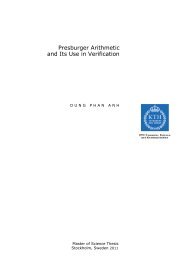User Centered Design in Practice - Problems and Possibilities
User Centered Design in Practice - Problems and Possibilities
User Centered Design in Practice - Problems and Possibilities
Create successful ePaper yourself
Turn your PDF publications into a flip-book with our unique Google optimized e-Paper software.
A case study <strong>in</strong> human-centred design<br />
The Swedish National Employment Service - AMS<br />
<strong>Design</strong><strong>in</strong>g a graphical user <strong>in</strong>terface for the new AMS<br />
Information System - AIS.<br />
Nigel Claridge (nigel.claridge@nomos.se)<br />
Tomas Berns (tomas.berns@nomos.se)<br />
Nomos Management AB<br />
www.nomos.se<br />
Introduction<br />
The Swedish National Employment Service - AMS developed a new computer system the<br />
objective of which was to support the Swedish employment process, career counsel<strong>in</strong>g<br />
<strong>and</strong> job-related rehabilitation. It was to be used by some 10 000 Swedish employment<br />
officers on a daily basis as it conta<strong>in</strong>ed <strong>in</strong>formation about employers, job vacancies <strong>and</strong> a<br />
register of all job seekers. In the future, members of the public will have access to parts of<br />
the system through the Internet.<br />
By November 1995, a prototype W<strong>in</strong>dows-based user <strong>in</strong>terface had been developed<br />
<strong>in</strong>ternally but there were some serious concerns about its usability. AMS commissioned<br />
that <strong>in</strong>terface to be evaluated for usability by external <strong>in</strong>dependent usability consultants.<br />
Both expert <strong>in</strong>spections <strong>and</strong> a user test<strong>in</strong>g method were applied. Results <strong>in</strong>dicated clearly<br />
that the then current <strong>in</strong>terface did not support the efficient <strong>and</strong> effective execution of tasks.<br />
Based on these results AMS decided to halt the <strong>in</strong>terface development process <strong>and</strong> restart<br />
design.<br />
This short paper gives an overview of the user-centered design process that was<br />
applied <strong>in</strong> the development of AIS from November 1995. The subsequent user-centered<br />
design activities that were carried out are briefly described together with some of the<br />
benefits they had for the development as a whole.<br />
The actual work carried out <strong>in</strong>cluded the follow<strong>in</strong>g activities: Context analysis of<br />
AIS, an Expert (heuristic) evaluation on AIS, measurable goal formulation, a Parallel<br />
design activity to create a new user <strong>in</strong>terface design concept, design support activities,<br />
three iterations of user-based test<strong>in</strong>g on the new AIS design concept, a SUMI evaluation<br />
on the current AF-90 system <strong>and</strong> all iterations dur<strong>in</strong>g the development process. A series<br />
of focus groups were run early <strong>in</strong> development to glean functional requirements from endusers<br />
<strong>and</strong> then later <strong>in</strong> development to establish possible reasons prevent<strong>in</strong>g a smooth<br />
<strong>in</strong>troduction of the new AIS system to the workplace.<br />
42 (85) CID-40 • <strong>User</strong> <strong>Centered</strong> <strong>Design</strong> <strong>in</strong> <strong>Practice</strong>

















